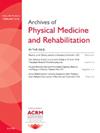Assessing the Use of Dry Needling for Integrative Pain Management During Inpatient Therapy 1142
IF 3.6
2区 医学
Q1 REHABILITATION
Archives of physical medicine and rehabilitation
Pub Date : 2025-04-01
DOI:10.1016/j.apmr.2025.01.057
引用次数: 0
Abstract
Objectives
Although dry needling (DN) has been used in a variety of outpatient settings to address pain, this is the first study analyzing DN with adults during inpatient rehabilitation. Primary objectives: to examine the effects of DN for pain management. Secondary objectives: to explore the effects of DN on daily activities, sleep, anxiety, therapy compliance, and medication usage.
Design
This was a randomized controlled trial with a parallel-group design and 1:1 allocation ratio.
Setting
The study was conducted at Atrium Health's Carolinas Rehabilitation in Charlotte, North Carolina, which is a non-profit inpatient rehabilitation hospital in an urban setting attached to a Trauma-1 Medical Center.
Participants
Forty-two adults were enrolled from a sample of convenience while undergoing inpatient rehabilitation in a facility that serves a diverse patient population including individuals post brain injury, spinal cord injury, oncological disease, and a variety of complex medical diagnoses.
Interventions
The 2 groups in this study were randomized to receive DN with manual therapy or manual therapy treatments only for pain management. All subjects received the “usual care” of the inpatient rehabilitation hospital including physical, occupation, and/or speech therapy treatments as well as nursing and medical interventions.
Main Outcome Measures
Outcomes included the Visual Analog Scale for Pain, Patient-Reported Outcomes Measurement Information System (PROMIS) questionnaire for Pain Interference, Sleep Disturbance, and Emotional Distress-Anxiety, the amount of time patients refused therapy due to pain, and PRN pain medication use.
Results
Both groups demonstrated significant improvements pre-post treatment on visual analog scale for pain, PROMIS for pain interference, and PROMIS for emotional distress-anxiety. No changes were found for PROMIS—sleep disturbance, therapy refusals, or use of pain medication. There were no significant differences between groups on any outcome measure after treatment.
Conclusions
This research highlights the benefits of both MT and DN as an adjunct treatment for pain during inpatient therapy. No adverse events occurred showing that DN is safe and feasible during inpatient rehabilitation with adults in a complex medical state.
Disclosures
none.
求助全文
约1分钟内获得全文
求助全文
来源期刊
CiteScore
6.20
自引率
4.70%
发文量
495
审稿时长
38 days
期刊介绍:
The Archives of Physical Medicine and Rehabilitation publishes original, peer-reviewed research and clinical reports on important trends and developments in physical medicine and rehabilitation and related fields. This international journal brings researchers and clinicians authoritative information on the therapeutic utilization of physical, behavioral and pharmaceutical agents in providing comprehensive care for individuals with chronic illness and disabilities.
Archives began publication in 1920, publishes monthly, and is the official journal of the American Congress of Rehabilitation Medicine. Its papers are cited more often than any other rehabilitation journal.

 求助内容:
求助内容: 应助结果提醒方式:
应助结果提醒方式:


